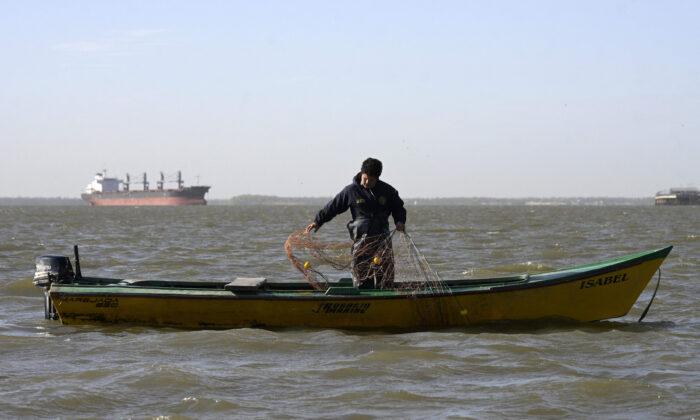Hundreds of Chinese fishing vessels fill the seas near the maritime borders of South American countries. While appearing modest, the fleet of small fishing vessels is among an armada of ships financially supported by the Chinese regime, with a portion potentially involved in illegally fishing other nation’s territorial waters.
Off the coast of Argentina, some of these ships are reported to turn off their mandatory tracking devices at night to fish illegally within other nations’ exclusive economic zones.
Oceana documented over 6,000 gap events, during which vessels were invisible for more than 24 hours, “hiding fishing vessel locations and masking potentially illegal behavior, such as crossing into Argentina’s national waters to fish.” The ships were undetectable for 600,000 hours in total, and the Chinese fleet was responsible for 66 percent of those incidents.
Moreover, 523 boats were detected in the Southwest Atlantic, near Argentina, between November 2020 and May 2021. Of those, 42 percent “went dark” at least once, as they turned off their transponders.
Meanwhile, in the Southeast Pacific, a vigilante patrol called the Ocean Warrior recorded 16 cases of Chinese ships turning off their tracking devices, broadcasting multiple electronic IDs, and transmitting information that didn’t match listed names and locations. About 24 of the boats sailing in the area had a history of labor abuse accusations, illegal fishing convictions, or appeared to be in violation of maritime law.
Urbina states that the fleet is “primarily fueled” by the CCP, adding that China’s fishing fleet “acts as a projection of geopolitical power on the world’s oceans.”
He further cites Greg Poling, director of the Asia Maritime Transparency Initiative, saying that “the scale and aggressiveness of its fleet puts China in control,” and that foreign countries are not willing to fight back Chinese fishing ships that enter their waters.
Urbina said that in 2018, the Chinese regime awarded its fisheries subsidies of $7.2 billion, which includes money for fuel, new boats, engines. This amounts to roughly 20 percent of estimated global subsidies in the industry.
Chinese company Pingtan Marine and its affiliates, which deploys China’s second-largest overseas fleet and is listed on the Nasdaq, was allegedly built on state loans, subsidies, and its CEO Zhou Xinrong’s connections within the CCP, reported AP.
Two U.S. officials said former President Donald Trump banned Zhou and his wife from entering the United States for being complicit in illegal fishing and human trafficking.
Indonesia’s former foreign fishing minister said Pingtan is “not just a fishing company—it’s practically a Chinese government asset.”
For example, Pingtan received $29 million in subsidies in the first nine months of 2020 and $280 million in loans from the China Development Bank and other state lenders, as reported in its last earnings report.
Overfishing
China’s exploitation of areas further and further from their shores comes after decades of overfishing near home. This constitutes a major problem for South America, as industrial Chinese fishing may pose a threat to local fishermen’s source of livelihood.Chinese vessels usually remain on the high sea near the Americas—outside the countries’ maritime jurisdiction—while fishing for Humboldt squid.
Though squid is abundant in the area, experts caution the species may also suffer from overfishing, citing instances of stock disappearance in Argentina, Mexico, and Japan.
The region is vulnerable to abusive fishing from China, according to Captain Peter Hammarstedt, director of campaigns for Sea Shepherd, an activist organization for the conservation of marine fauna. He blames China for the plunder of tuna and shark in Asia, and claims there is no reason to believe they will “manage this new fishery responsibly.”
Hammarstedt also pointed out that the South Pacific Ocean is like the “Wild West,” as “nobody is responsible for enforcement out there.”
As the high seas have no regulations, non-profits are pushing for a High Seas Treaty, pursuing the creation of restrictions on fishing in international waters.
Recently, hundreds of Chinese ships were found fishing near the Galapagos Islands, a UNESCO world heritage site that is home to several endangered species. The finding spurred the deployment of a vigilante patrol called the Ocean Warrior in the South Pacific to keep track of fishing activity.





